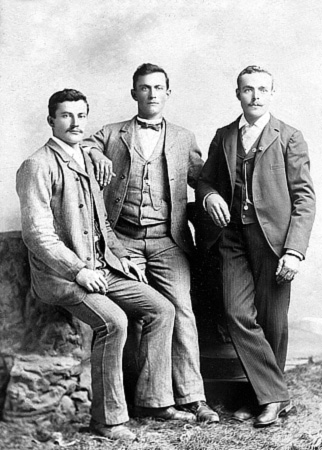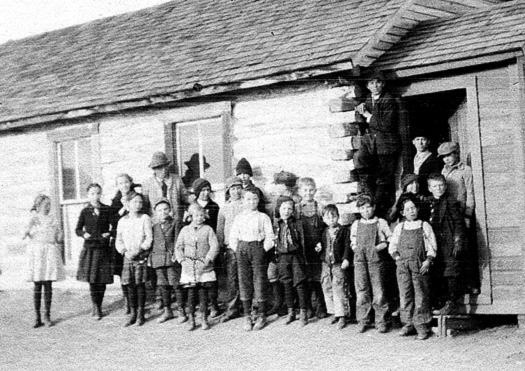
 |
|
My parents, Jacob and Mary Natalia Leistiko were emigrants from Europe. I don't know where they departed from in Germany but they told us they landed in New York USA and came to several places in North Dakota. I was born in Grand Forks, North Dakota, in 1896. My Dad immigrated in 1890 and was naturalized in 1905. My mother Mary immigrated in 1892. They settled in Montana on Second Point on the Missouri River where my Dad squatted on the ranch before it was surveyed. Squatting was allowed before land was surveyed. The ranch was on the river bottom and included a lot of high ground. The bottomland was our hay meadow while the hilly area was pasture. Dad built our first home with cottonwood logs on high ground which proved to be a wise decision because of ice jams on the Missouri river and some springs that flooded the low land to more than twelve feet in depth.
My Dad and Uncle Fred, a brother of my mother, built a little log house for my grandparents Johan Friedrich Leistikow and his wife Luiza Rapsch near the Missouri river where Dad fished. Dad sent his catch once a week to Glasgow with the mailman. Mail was sent to us only on Friday each week. Grandpa made a large wooden box with many holes for water to flow through and put the fish in it so they would stay alive until time to send them to market. My Dad and Uncle Fred worked on many projects together.
Uncle Fred lived on the river about three miles upstream from us. Second Point is in Valley County, Montana, on the Missouri River, and is now under water since the Fort Peck dam was built. Water now covers our ranch. After that we lived on the farm which was half of a 640-acre section of land, while Uncle Fred and his family lived on the other 320-acres. The homestead papers were filed in 1916.

Rose and Jacob Daum (with the hat) are second and third from the left in the back row. Ted and Bertha Leistiko are second and third from the left in the front row (not counting the girl on the far left). Fred Leistiko (with the cap) is leaning against the doorway in the back, by the teacher, Mary Ebersol. |
We spoke only German and when we two oldest boys started going to a one room, one teacher school, we had a language problem. We walked the two miles to and from school. It took longer for our parents to speak English fluently than for us kids. Our bucket of river water for drinking was kept on a shelf at the back of the room, and in cold weather sometimes had a thin layer of ice on it. We all drank out of a long-handled, tin drinking cup.
My earliest memory is of a near-starved fawn we found in the woods after a hunter had shot its mother. We carried it home and bottle-fed it and it became a very lovely pet and playmate. It followed us everywhere. To our sorrow, this almost full grown pet and playmate was killed by a hunter. He came to tell us what he did, not knowing it was our tame deer until he found it had a short rope around its neck. Tears were shed for our dead pet.
We always had wild ducks in season and prairie chicken, sage grouse, beef, milk, butter and garden produce. We were pioneers and lived off the land. We were so far from Glasgow it took one full day to drive to town, by wagon and team of horses, and one day to return. Horses were kept in a livery barn for 50¢. We slept in a hotel but I don't remember what it cost way back then. I do remember Dad coming home with a wagon box full of groceries, which was enough to last a long winter through.
Dad was a hard worker and taught us boys by example and by word of mouth. We had about 300 head of cattle and about 50 horses on the open range and often my brother Eddie (Ed) and I would ride out to check on our livestock. One time Eddie and I were loping along side-by-side when his horse stepped into a gopher hole and broke its leg. Eddie then took my horse and managed to rope one of the wild horses near by. After quite a struggle we got a saddle and bridle in place and Eddie in the saddle. We were both on horseback while my brother's horse was trying very hard to rid its excess.
We always carried a coiled rope strapped to the right side of the saddle and a gun for shooting coyotes. We were unable to help the horse with the broken leg so we shot it. We sometimes found animals mired down in the willow creek and nearly always were able to pull them out with a rope and horsepower.
One time while riding alone I came upon a coyote den in a washout. After making my way into this washout, in a semi-dark place I found 5 half grown coyote pups backed up to get as far away from me as they could. Their mouths were open and eyes shining. I tried to determine how I could get these 5 pairs of ears and 5 dead coyotes. I was determined to get them somehow. Grabbing the first one by the front legs was not the way. I soon found this out, as it sank its needle sharp teeth into my right wrist and would not release its bite until I choked it. Then after thinking how the mother carries her young I slowly reached over its head and took it by the nap of the neck and it worked. So, I crawled out of this washout with the first pup and killed it by taking a hold of its hind legs and hit its head on a rock. After 4 more trips crawling into the washout I had my 5 pairs of coyote ears for which I got 10 silver dollars which was a lot of money back then. Coyotes killed many calves, so a bounty was paid for each pair of ears … in real silver dollars.
Another killer of animals on the open range was the porcupine. They would drive their needles into an animal's snout, leaving the critter unable to graze. It would soon die of starvation if the needles were not removed. We were able to pull these needles out with pliers.
Dad had constructed a dam across a dry creek, which held six feet of water when full. In the summer we swam in it, and in the winter we skated on it. We also shot many ducks in season. On one occasion I got 5 ducks with one shot with our 12-gauge shotgun.
Mother used feathers for feather beds. She used prairie chicken, duck, and sage grouse feathers.
For entertainment we made stilts, skis, rafts, hunted, fished, and hunted for snakes. One time, as I remember, when Eddie and I were chasing a large bullsnake when it started crawling into a gopher hole. Eddie and I both grabbed it and pulled as hard as we could, while the snake kept getting deeper, until all at once the snake's skin came off and we no longer were pulling on the snake. (Snakes shed their skins each year.) We always found plenty of things to do for entertainment.
Our mother was a very patient woman who often used the expression, "vas in allenvelt" ("What in the world?") when her boys came up with some unusual pranks. Dad was much more serious and did not pay attention to our pranks.
My first job while still very young was helping Mr. Patterson move across the river to a new location many miles away. My job was to ride my horse behind all of his livestock as we crossed a rock-bottomed ford on the Missouri river, and to make sure no cattle would drop out. Mr. Patterson and another man were in the front, in two wagons. I remember being homesick. I had to find my own way back and had to cross back over in a ferry … all of which was a worry to me.
Eddie and I were once asked to take a job operating a rear-paddle-wheel ferry on the river. This ferry had a Ford tractor engine, which stalled often, and left us drifting down stream until we hand-cranked the engine. It was very scary for us. So we tied the ferry to a cottonwood tree and served notice that we would not operate it any longer.
My next job was cooking for a road building crew of 8 workers with horses. My mother helped me get started and I cooked three meals daily in a cook shack on wheels. This job lasted until the ground froze and road building stopped.
Our hardest work was cutting wood for heating and cooking with a two-man saw. It took many cords of wood and it was always done one year in advance. Uncle Fred had a sawmill and sawed up many trees and several large piles of lumber for sale and for building his and our homes on our farms later.
One time Dad let us 3 oldest boys choose a personal saddle horse, but each one of us had to break it. I chose a beautiful horse that had a white star on its forehead and I named it Star. My first time in the saddle was a failure as Star promptly got rid of its rider. Then Eddie did the bronco busting for me and Star lost out. Eddie was a good bronco buster. After Star was fed a lot of oats and petted, and he found out I was trying to be a friend, he turned out to be a beautiful saddle horse. It makes me sad that I just walked off and let him roam, never to see each other again.
Our brand was the lazy AD, placed on the right shoulder of our cattle and horses.
There is much more that can be told in this story. Perhaps sometime later, the Lord willing, I hope to tell more.